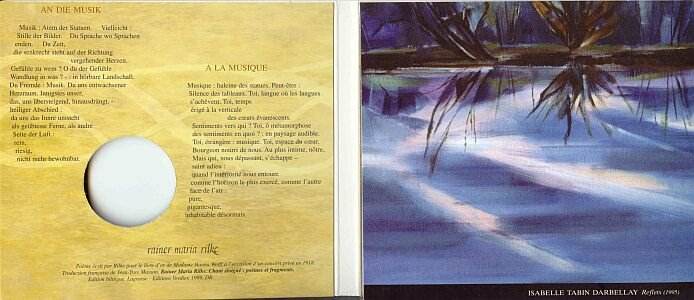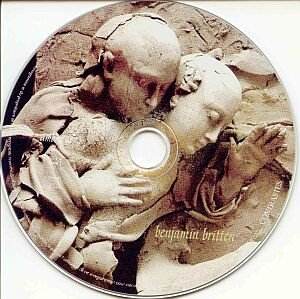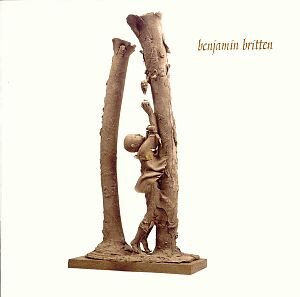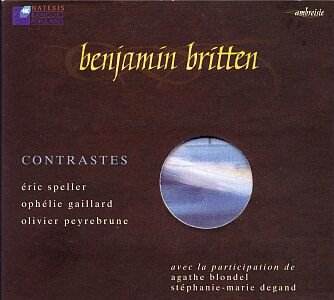
They say that you should never judge a book by its
cover. But, they also say that you shouldnít look a gift horse in the
mouth. Then again, a bird in the hand is worth two in the bush. But,
whatís this got to do with the price of eggs? Well, this CD is beautifully
packaged. One of these cardboard jobs, a tasteful chocolate-brown
with a tantalising peep-hole affording a tempting glimpse of the art-work
to be fully revealed when you open it out. The CD nestles in a central
tray with the booklet slotted on the right (so if youíre left-handed,
be warned!). You also get poetry, and pictures on both the packaging
and the disc, credits everywhere - and on the back thereís even
a summary of the musical contents. The mind boggles - the next thing,
thereíll be a little pink ribbon tied in a bow!

Not all, however, is sweetness and light. The CD seems to be sitting
up very seductively, but (unless you have finger-nails like razor-blades)
proves a real brute to extract - affording you the opportunity of a
sense of achievement in the domestic environment similar to that of
getting to a concert in the cold, wet and dark, when the car wonít start
and the omnibuses are hibernating. The gorgeous illustration on the
CD label does rather tend to obscure the words - as I write, Iím not
sure that Iíve even found them all. The poetry turns out to be
a single verse entitled "To Music", penned in 1918 by Rainer
Maria Rilke, repeated in four languages (surely, if this is meant -
as I suspect - to be a "Euro-CD", shouldnít it be in about
a dozen languages? Never mind - four is already three too many). You
may like the poem, but I must confess that I, ever the euphemistically
rough-hewn Yorkshireman, found it more than a nadge on the airy-fairy
side.
Enclosed with the booklet, which was easy enough to
extract (the main problem here is to actually stop it slipping
out. Mind you, itís less easy to get it back in!) I discovered an introduction
to the record company, in the same four parallel languages. Perusing
it, I groaned inwardly: "Ambroisie is a new record label which
aims to use the sensual pleasure of sound to bring alive the desire
for eternity, the traces of ambrosia, that we all carry inside us."
It burbled on, basically telling us (I think) that their CDs are a cut
above the common, commercial rabble, presenting utterly fresh views
of music by "putting the musician back at the centre of attention"
- basically, the same idea as the internet-based label Artist-Led.
The reference to "the appearance of new media . . . rocking the
record industry", however, did rather give the game away.
The booklet itself is crammed - largely on account
of the same text being presented (again) in three languages too many.
Why do record companies in general do that? Donít they realise it unnecessarily
depletes the rain forests? I wouldnít have minded so much, were it not
that the introduction, two extracts from "Le Principe de Delicatesse"
by Michel Onfray, read like one of those arty-farty French films where
the characters explore their own navels at interminable length, in impenetrably
profound dialogue, and to little or no consequence. What on Earth is
meant by such as "In the logic of the elements, Britten would have
been Water (certainly not Fire or Earth), if he had not been Air"?
Iím blowed if I know (which presumably makes me "Air") - in
my world, weíve got over a hundred elements, and none of them are as
quoted. Do you think this blokeís also a member of the Flat Earth Society?
Then - joie de joies! - things took a distinct
turn for the better in Michel Fleuryís discussion of the music. The
language remains, albeit now eponymously (or thereabouts), "flowery",
but the half of it of which I could make head or tail actually provided
useful information - íecky thump! The only real problem is that
Fleury is prone to prescription. Thatís alright in itself and in the
right place, but bearing in mind that a CD note is likely to be read
by some with no prior knowledge, a writer needs to be careful. For example,
of the first of the Two Insect Pieces, he says, "Insect
jumps, twisting and abrupt veering: one is amazed at the realism of
the portrait." Well, Brittenís title notwithstanding, the image
that I got was of children playing hide and seek, so that makes me one
who is not amazed at the realism of the portrait. No skin off my nose,
but "beginners", unaware that these things are not absolute,
might be a mite discouraged if the prescribed image didnít present itself
to their mindís eyes. "Read with caution" would seem to be
the watch-phrase. Detailed profiles of the five young players are also
provided, thankfully in plain English (oh - and French, and German,
AND Spanish).
If I seem to have rather rabbited on about what is,
when allís said and done, only the packaging, I apologise - but with
such elaborate production I felt fairly obliged to reciprocate in kind!
OK then, to the music. I must confess that, being a sucker for colourful
orchestration, works like the Frank Bridge Variations, The
Young Personís Guide to the Orchestra, the Sinfonia da Requiem,
and especially the astonishing (and astonishingly neglected) ballet
music for The Prince of the Pagodas (to name but the four that
most immediately spring to my mind) have all too easily blinded me to
the more intimate side of Brittenís output. Almost paradoxically, the
only work on this disc of which I have any prior knowledge is the Six
Metamorphoses after Ovid, which is for a splendidly isolated oboe!
The disc includes three early works, one from the zenith
of his creativity, and one late work. Although they are described in
chronological order, only the last occupies a corresponding place in
the disc, which can be a bit aggravating if youíre listening to the
lot in one gulp (and 77 minutes makes for a creditably generous gulp).
However, as the twiddly bits on a CD player are designed specifically
to compensate for the unfathomable capriciousness of CD producers, I
was able to do a quick spot of re-ordering, whilst pondering on how
quickly we take for granted what was once considered the height of "high-tech."
luxury - though in my opinion the effect is nothing like as pronounced
as the plummet in status, from exclusive executive plaything to ubiquitous
pollutant, of the mobile Ďphone.
It gave me quite a jolt: here was Britten flayed to
the bone, stripped of all the comfortable upholstery to which Iíd become
accustomed. The effect was strikingly similar to my early experience
of Bartok - having started in the plush velour of the Concerto
for Orchestra, Dance Suite, and Miraculous Mandarin
(parallels with Prince of the Pagodas, perhaps?), I was stunned
when I encountered the raw nerve-endings of the six String Quartets.
Now, more years down the line than I care to count, here we go again!
All those little peculiarities that define "Benjamin Britten"
- the terse phrases, motives that are all elbows, nervous trills and
melismatic musings - became the wood exposed by removal of the trees.
Listening to the earliest work, the Phantasy Quartet,
which is also (comparatively speaking) the most densely populated in
instrumental terms, there were parts where I couldnít help but recall
the Stravinsky of The Soldierís Tale, or the Ravel of the String
Quartet. Maybe youíll find different echoes of the composerís recent
past - probably, and not unreasonably, they all add up to partially
assimilated influences. In and amongst marvelling at Brittenís enchanting
use of instrumental colour - especially the way he complements and contrasts
the oboe and the strings - you find that these teasing little similitudes
make the music all the more spell-binding.
The shadow of Brittenís senior, Bela Bartók,
not surprisingly looms large in the Two Insect Pieces, in which
the string trio is replaced by the percussive piano, calcifying those
bones and to some extent crystallising Brittenís maturing style. In
the first, the hip-hopping quality of the pecked two-note phrases and
the oboeís wary held notes at the ends of the "sentences"
effectively mimic the cavortings of the purported "Grasshopper".
However, Iím not so sure about "The Wasp"; although there
are some fairly savage Bartokian rhythmic eruptions from the piano,
the oboe simply sounds too nice to conjure the memory of any
wasp that Iíve ever had the misfortune to meet. In this movement, I
would have expected the oboist to have dripped vitriol into his reed
and made some really nasty sounds - in the right hands (and even
more so in the wrong hands!) the instrument is more than capable of
producing them, and Britten certainly provided opportunities a-plenty!
Speaking of the Temporal Variations of 1936,
Fleury suggests that the "enigmatic title" might relate to
Brittenís being "intensely receptive to the climate of anguish
created by international tensions". Inasmuch as "temporal"
refers to things characteristic of Life on Earth and the variations
run a minor gamut of pungent emotions, and in view of movement titles
like "Oration", "Commination" and "Chorale",
Iíd go along with that. But, the word also relates to things which exist
only briefly, and these variations are all pretty epigrammatic. Then
again, it can refer to preoccupation with practical (as opposed to spiritual)
matters, which jibes well with others of the titles: "March",
"Exercises", "Waltz", "Polka". Perhaps
itís not so much enigmatic as (if youíll pardon my French) an entendre
multiple. Whatever, the titles of the movements all imply distinctive
characters which are projected with considerable distinction by the
players. So what if Brittenís cautionary non troppo lento has
perhaps been overlooked in the final Resolution? The portentious
obsession of the oboeís incessant repetition of the same "resolution"
makes a pretty seductive carrot, and really itís just pettifogging to
complain, particularly when set against (say) the bright and brittle
jollity of the March, or the elastically-observed allegretto
rubato of the Waltz.
In relation to the Six Metamorphoses, Fleury
makes a telling point all the more telling by not mincing his words:
". . . one of the most difficult genres [for all concerned]: that
of monody . . . here the composer works without a safety net,
for he must hold the listenerís attention without the devices offered
by polyphony and harmony." The involuntary image of the player
precariously poised on a tightrope is both immediate and apposite -
and the pose must be held for nearly 14 minutes! With music this concentrated,
thatís a tough enough proposition, but as I listened a problem emerged:
either Fleury in his commentary is overstating the case, or Speller
in his performance is understating it. Whichever, the two seem a bit
short on common ground. By adopting a general tone of "classical
coolness", as in The Wasp the oboe simply sounds too refined
for what are supposed to be the more rugged, hair-raising movements
like Phaeton or Bacchus, and seems to lack the dynamic
daring "to boldly go" for the alternation of forte
and piano required in Narcissus, for fear his tone (heaven
forbid!) might suffer. It all sounds very civilised, but is it what
Britten was after, especially when writing a quarter of an hourís music
for that "ill wind instrument that nobody blows good"?
That leaves the first íCello Suite. That this
is a product of Brittenís artistic (and alcoholic) empathy with Rostropovich,
and a form inviting comparison with J. S. Bach, is elaborated with great
artfulness by M. Fleury who concludes (I think) that the collaborators
deliberately set out to emulate JSB, and at the same time use the tactile
intimacy of the medium to share their common experience of "the
tragedy of the human condition". So, pretty brow-furrowing stuff,
then? Well, yes - particularly in the Cantos that punctuate the
variational structure, where the shadow of the third party of a loose
triumvirate, Shostakovich, looms large - Britten, it would appear, was
paying tribute to more than JSB! In fact, the frequently anguished intensity
makes you wonder just what they chatted about at those Bacchic Celebrations.
I was going to say that, generally, Gaillard seems far more prepared
to let rip and take a few risks with her ícello than does Speller with
his oboe. When it comes down to it, she does, but then whilst
driving on a solemn mission the other day I heard something on the car
radio that brought me up short: Rostropovichís own recording of this
music. By comparison, it sounded terrible - in both senses of
the word: nowhere near as sweetly articulated, and trouser-staining
in its visceral intensity. Gaillard does nothing wrong: she simply does
not do enough.
The recording is very good, full, clear, nicely rounded
and set to the fore of a pleasantly open acoustic. But be warned, particularly
if youíre a headphone listener: the recording engineers, presumably
in collusion with the performers, have not maintained a consistent balance.
As the record proceeds from work to work, from one grouping of instruments
to another, itís as if you are also on the move, ever chasing that elusive
best vantage point from which to listen. I can see what theyíre aiming
for, but honestly I prefer to stay in the one seat for the duration
of the concert, thankyou very much! This adjustable perspective has
a further drawback. Broadly speaking, theyíve set the larger ensembles
further back on the sound-stage. These are fine, but when you come to
the pieces for unaccompanied soli, you find yourself a bit too close
for comfort - the old "Segovia Principal" kicks in.
To sum up, these are fine, accomplished renditions,
proficient and beautifully articulated, a joy to hear, and all-in-all
very refined and attractive-sounding at first acquaintance. But therein
also lies the down-side - as you become more familiar they begin to
seem too refined: thereís a characteristically Gallic suavity
that doesnít penetrate to the core of Brittenís often nerve-jangling
music. Just listen to Gaillard and then to Rostropovich in the íCello
Suite, and youíll immediately get the point (if you buy this record,
then avoid the Rostropovich recording! And, probably, vice
versa). Iíve a feeling that, after all that Iíve said, Fleuryís
flowery notes are actually much more in tune with the music than are
the performances. To a degree, what the Contrastes ensemble fails to
do is "what it says on the tin". Coming full circle, this
turns out to be one book that I could have judged by its cover.
Paul Serotsky



